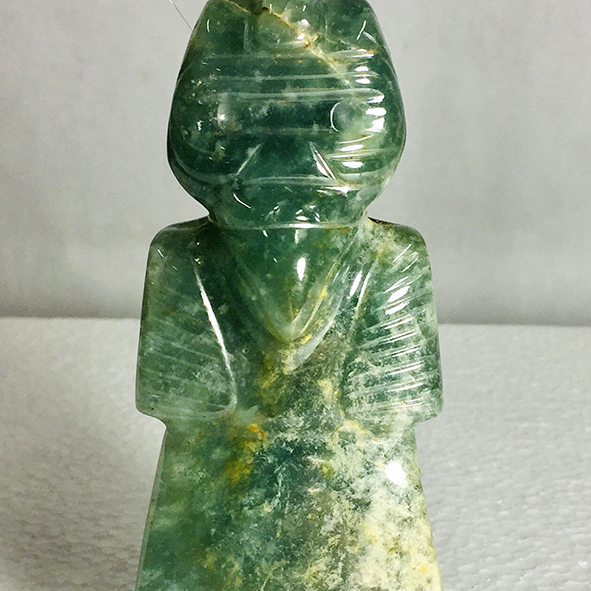Abstract
In this study, we focus on the “axe-god” jade pendants, which dominate the large part of jade artifacts in Costa Rica. These pendants are known that the denomination is not by means of its function as real axes, but its axe-like shape. However, the author thinks that there is a possibility that some of them had been used as tools before or after being reworked for the pendants. The stylistic classification in this study aims to elucidate the functional aspects of the pendants, focusing on their size and shape, then combines these factors with motives. To support the hypothesis of the practical usage of the pendants, detailed analyses with a digital microscope are conducted to see the possible use-wear.
References
Aguilar, C. H. (2003). El jade y el chamán. Cartago: Editorial Tecnológica de Costa Rica.
Corrales, F. (2001). Los primeros costarricenses. San José: Museo Nacional de Costa Rica.
Creamer, W. (1987). Mesoamerica as a concept: an archaeological view from Central America. Latin American Research Review, 22(1), 35-62.
Chenault, M. L. (1986). Technical analysis of precolumbian Costa Rican jadeite and greenstone artifacts (Tesis de maestría inédita).University of Colorado, Boulder, Colorado, Estados Unidos.
Fonseca, O. y Scaglion, R. (1978). Stylistic analysis of stone pendants from Las Huacas Burial Ground, northwestern Costa Rica. Annals of Carnegie Museum of Natural History, 47, 281-298.
Guerrero. J. V. (1993). The context of jade in Costa Rica. En F. W. Lange (ed.), Precolumbian jade: new geological. and cultural interpretations (pp.191-202). Salt Lake City, Utah: University of Utah Press.
Guerrero, J. V., Solís, F. y Solano, F. (1992). Entierros secundarios y restos orgánicos de ca.500 a.C. preservados en un área de inundación marina, Golfo de Nicoya, Costa Rica. Vínculos, 17(1-2), 17-52.
Hartman, C. V. (1907). Archaeological researches on the Pacific cost of Costa Rica (Memories of the Carnegie Museum, 3(1)). Pittsburgh: Carnegie Institute.
Herrera, A. (1997). Espacio y objetos funerarios en la distinción de rango en Finca Linares. Vínculos, 22(1-2), 125-156.
Hoopes, J. W. (2005). The emergence of social complexity in the chibchan world of southern Central America and northern Colombia, A.D.300-600. Journal of Archaeological Research, 13(1), 1-47. doi: 10.1007/s10814-005-0809-4
Inizan, M.-L., Roche, H., y Tixier, J. (1992). Technology of knapped stone. Followed by a multilingual vocabulary (Arabic, english, french, german, greek, italian, russian, spanish). Lee, Alan. Préhistoire de la Pierre Taillée, Tome 3. Originally published in French in 1980 as Préhistoire de la Pierre Taillée by Tixier, Inizan, and Roche. Meudon: Meudon, France: CREP and CNRS.
Jones, J. (1999). Jade in ancient Costa Rica. The Metropolitan Museum of Art. New York: The Metropolitan Museum of Art.
Lange, F. (1993). Formal classification of prehistoric Costa Rican jade: a first aproximation. En F. W. Lange (ed.), Precolumbian jade: new geological. and cultural interpretations (pp. 269-288). Salt Lake City, Utah: University of Utah Press.
Mora-Marín, D. (2016). The “Charlie Chaplin” silhouette figural theme: a pan-middle american ritual performer theme. Cuadernos de Antropología, 26(1), 9-45. doi: 10.15517/cat.v26i1.25274
Reynoard, M. (1996). El papel del fade en el proceso socio-cultural de las sociedades antigüas de Costa Rica (Tesis de licenciatura inédita). Universidad de Costa Rica, San José, Costa Rica.
Snarskis, M. J. (1979). El Jade de Talamanca de Tibás. Vínculos, 5(1-2), 89-107.
Snarskis, M. J. (2003). From jade to gold in Costa Rica: how, why, and when. En J. Quilter y J. W. Hoopes (eds), Gold and power in ancient Costa Rica, Panama, and Colombia (pp. 159-204). Washington, D.C.: Dumbarton Oaks.
Soto, Z. (1993). Jades in the Jade Museum, Instituto Nacional de Seguros, San Jose, Costa Rica. En F. W. Lange (ed.), Precolumbian jade: new geological. and cultural interpretations (pp. 68-72). Salt Lake City, Utah: University of Utah Press.
Stone, D. (1963). Cult traits in southeastern Costa Rica and their significance. Antiquity, 28(3), 339-359.
Stone, D. Z. y Balser, C. (1965). Incised slate disks from the Atlantic Watershed of Costa Rica. American Antiquity, 30, 310-329.


